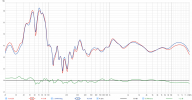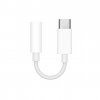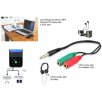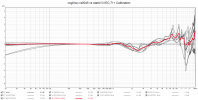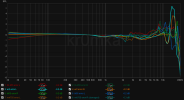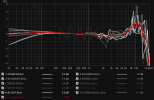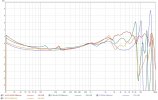Hello,
First of all I‘d like to say I’m super impressed with the wealth of exact information and knowledge available here. I had a homestudio once but started traveling about five years ago and haven’t done anything with recording music since. It is now that I’ve temporarily settled in a place where I feel I want to record and mix some songs I’ve written along the way. I’m making do with an iPad Air 3 (Cubasis) a Rode NT USB and a Beyerdynamic DT770 Pro 32 Ohm and want to record acoustic guitar (using the mic) and piano (an old Kawai ES110).
Last thing missing are monitors. I thought about getting the Presonus Eris E3.5 or Edifier MR4 as they are the cheapest options with lots of positive reviews but then I found this website and read they’re actually next to horrible and now I feel the only option for me are JBL’s LSR305 or 305P MKII.
I have a live-in job at a hotel in the Uk and live in a caravan on site. it’s got nice enough sofa‘s and rugs but obviously it’s untreated.
Now the question I have is, after having read all the reviews, information and seeing all the highly technical data if it’s actually worth it to buy these monitors for mixing and if so, if I could make do with a 3.5mm to 1/4 Y-split cable or need an Audio Interface. I really want to spent as little as possible plus I will most likely sell the piano and monitors once I leave here in a few months time and my recordings and mixes don’t have to be state-of-the art but good enough.
i suppose after having found this website and seeing the technical angle and exact measurements here I suddenly feel intimidated and reduced to consumer level insight. I’ve always been a member of KVR Audio for eg. but compared to this website the information there is almost anecdotal rather than factual. I suppose the exactness of data and compelling arguments about EQing and measurements here makes me question whether I shouldn’t just mix on my headphones as the investment in monitors and/or AI would be futile when not treating the room or EQ them.
I‘m a musician first and and a hobbyist soundguy last and I realise now even more than before it’s such a diffferent craft and artform. Maybe I was just kidding and entertaining myself back when I still had a ‘proper’ homestudio -which isn’a bad thing per sé- but at this point, given the temporary nature of my ‘home’ I don’t want to fool myself. I hope this makes sense.
So to reiterate, from a professional/knowledgeable perspective would it be a waste to invest in monitors knowing I won’t treat the room, am limited in how I can position them, can’t do any measurements or EQing (I am hoping the Image Control Waveguide will be helpful here) and if not, how much soundquality would I sacrifice by using a simple Audio Out cable rather than a cheap AI? I‘ve never used iOS before to produce so I also have no idea how much the iPad’s DAC quality is over an AI.
PS. Sorry for the 101 question but I’ve been out of the game for too long and I‘d really appreciate some feedback. Thanks.
First of all I‘d like to say I’m super impressed with the wealth of exact information and knowledge available here. I had a homestudio once but started traveling about five years ago and haven’t done anything with recording music since. It is now that I’ve temporarily settled in a place where I feel I want to record and mix some songs I’ve written along the way. I’m making do with an iPad Air 3 (Cubasis) a Rode NT USB and a Beyerdynamic DT770 Pro 32 Ohm and want to record acoustic guitar (using the mic) and piano (an old Kawai ES110).
Last thing missing are monitors. I thought about getting the Presonus Eris E3.5 or Edifier MR4 as they are the cheapest options with lots of positive reviews but then I found this website and read they’re actually next to horrible and now I feel the only option for me are JBL’s LSR305 or 305P MKII.
I have a live-in job at a hotel in the Uk and live in a caravan on site. it’s got nice enough sofa‘s and rugs but obviously it’s untreated.
Now the question I have is, after having read all the reviews, information and seeing all the highly technical data if it’s actually worth it to buy these monitors for mixing and if so, if I could make do with a 3.5mm to 1/4 Y-split cable or need an Audio Interface. I really want to spent as little as possible plus I will most likely sell the piano and monitors once I leave here in a few months time and my recordings and mixes don’t have to be state-of-the art but good enough.
i suppose after having found this website and seeing the technical angle and exact measurements here I suddenly feel intimidated and reduced to consumer level insight. I’ve always been a member of KVR Audio for eg. but compared to this website the information there is almost anecdotal rather than factual. I suppose the exactness of data and compelling arguments about EQing and measurements here makes me question whether I shouldn’t just mix on my headphones as the investment in monitors and/or AI would be futile when not treating the room or EQ them.
I‘m a musician first and and a hobbyist soundguy last and I realise now even more than before it’s such a diffferent craft and artform. Maybe I was just kidding and entertaining myself back when I still had a ‘proper’ homestudio -which isn’a bad thing per sé- but at this point, given the temporary nature of my ‘home’ I don’t want to fool myself. I hope this makes sense.
So to reiterate, from a professional/knowledgeable perspective would it be a waste to invest in monitors knowing I won’t treat the room, am limited in how I can position them, can’t do any measurements or EQing (I am hoping the Image Control Waveguide will be helpful here) and if not, how much soundquality would I sacrifice by using a simple Audio Out cable rather than a cheap AI? I‘ve never used iOS before to produce so I also have no idea how much the iPad’s DAC quality is over an AI.
PS. Sorry for the 101 question but I’ve been out of the game for too long and I‘d really appreciate some feedback. Thanks.
Last edited:


